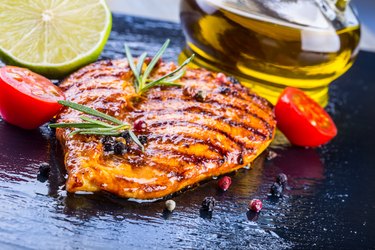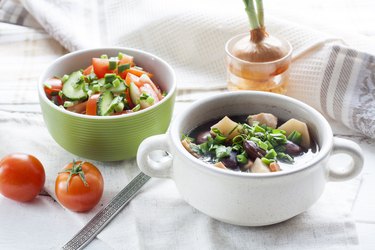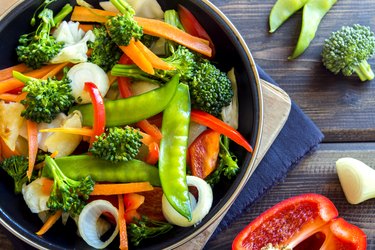
Not everyone has the willpower or time to make sweeping lifestyle changes. But the good news is that when it comes to losing weight, people who succeed the most often make small changes and see big — and, more importantly, lasting — results.
Incorporating gradual tweaks to your lifestyle makes it easier to maintain. "Making drastic changes overnight is not sustainable for most people," Amy Goodson, RD, CSSD, a registered dietitian in Dallas, tells LIVESTRONG.com. "They typically end up falling back into their own ways," Goodson says.
Video of the Day
Video of the Day
"But if people focus on making one to two small changes at a time and make those a habit every four to six weeks, they'll likely make eight to 10 changes over the course of a year that are now part of their everyday lives. That's much easier and much more sustainable for most people," Goodson explains.
Science backs up this approach, too. For example, a June 2016 study in JAMA Internal Medicine demonstrates that making small dietary and physical activity changes can help with maintaining weight loss.
"The key is not changing everything. It's changing one small thing at a time and doing it often."
In the study, researchers divided 599 participants into two groups: The first group focused on making small changes, which included cutting calories and increasing physical activity, like taking the stairs instead of the elevator. The second group of participants was asked to lose five to 10 pounds by cutting even more calories and adopting a more rigorous exercise routine. While the weight loss was gradual, those who made small changes were able to maintain their weight loss better over time than those who didn't.
That said, here are little diet changes you can start making today. In just a few short weeks, you'll see that you not only dropped the pounds, but you might just feel better and have more energy, too.
1. Go For Low-Fat Dairy
If you're a big dairy drinker or like adding milk to your smoothies, this simple change can save you a bunch of calories. Whenever you pour milk into overnight oats, opting for the low-fat version can save up to 47 calories per cup, according to the USDA.
But that's not to say that you should fear the fat in dairy completely, as long as you're enjoying in moderation. "Fat helps you feel full faster and stay full longer," Goodson says. In fact, incorporating low-fat dairy products in your meals, like yogurt and cheese, can help reduce body fat and preserve lean muscle, a May 2019 study in Nutrients suggests.
And if you're lactose intolerant or have a sensitivity to dairy, there are plenty of delicious non-dairy alternatives to choose from, including almond, cashew and oat milk.
2. Choose Leaner Meats

Just because you're trying to stay healthy and shed a few pounds, doesn't mean you have to cut meat from your diet entirely. Adding a leaner cut to your meal plan can actually help you crush your goals: Higher-protein diets, which include 25 to 30 grams of protein per meal, promotes greater satiety and weight loss, an April 2015 review in the American Journal of Clinical Nutrition found.
And if you struggle with cutting back on sugar and processed, packaged snacks, adding more protein to your diet can help curb cravings, too, Goodson says. All you need to do is go for lean sources of protein, such as chicken without the skin, turkey, fish, low-fat dairy, eggs and soy products, Goodson says. Lean cuts of red meat, like sirloin, flank and round steak, are also healthier alternatives to fattier cuts such as ribeye.
Don't forget to add plant-based sources of protein in your diet too, like tofu, lentils and quinoa. Choosing these lean sources of protein can not only save calories but cut down on saturated fat as well.
Read more: 5 Healthy Red Meat Recipes That Satisfy
3. Choose Your Carbs Wisely
Not all carbs deserve the bad reputation they get. Complex carbs and carbs found in foods rich in fiber — such as vegetables and fruits, and whole-grain breads and pastas — are great for fueling your body and giving you the energy you need to get through the day. "Eating high-fiber carbohydrates with protein can help stabilize blood sugar, which helps to minimize and/or prevent blood sugar highs and lows that often cause people to crave sugary foods," Goodson says.
However, refined carbs that have empty calories — such as those found in candies and sodas — should only be consumed in moderate amounts (if at all). "Have fruit instead of chips for a side item or swap a big sandwich bun for thinner whole-grain bread. You can even swap a veggie in for a side item when you're dining out. Simple swaps made consistently can add up to radical change," Goodson says.
While low-carb diets can help expedite weight loss in the short-term, restricting carbs is associated with an increased risk of mortality. A landmark August 2018 study in Lancet of more than 15,000 people observed that those who followed diets high and low in carbs had a shorter life expectancy compared to those who followed diets with moderate amounts of carbs. The study also found that replacing carbs with protein and fats from plant sources might lower the risk of death.
"The key is not changing everything. It's changing one small thing at a time and doing it often," Goodson says.
Read more: The Best Healthy Carbs You Should Be Eating More Of
4. Start With Soup or Salad

Eating a water- or broth-based soup or a fiber-filled salad before your meal helps fill you up, meaning you eat less of your entrée, which is often more calorie-dense than this type of appetizer.
In fact, starting your meal with a soup or salad is one of the tenets of the Volumetrics Diet, which focuses on making high-fiber foods the majority of your meal. The idea is that filling up on these low-calorie, high-fiber foods will promote greater satiety, thus helping you lose weight faster.
Tip
When ordering soup, just remember to avoid choosing a creamy soup like clam chowder, which adds on more calories, and opt for a low-fat salad dressing or just plain balsamic vinegar. Beware that fat-free salad dressings are high in sugar to make up for the fat, so you want to avoid those, too.
5. Create Smart Snack Portions
When you need to unwind in front of the TV after a long day at work, it's easy to grab a bag of chips and munch away. But be careful: This can cost you a load of calories.
Instead, measure out the serving you're aiming for, and then put the bag back in the cabinet and out of reach to help curb your desire for more. This applies to healthy snacks, too, like nuts and seeds, whole-grain crackers with cheese and low-fat Greek yogurt with berries. While these snacks are all nutritious choices, they are also caloric, so measuring out smart portions will prevent you from going overboard.
When it comes to choosing snacks, it's best to stick to ones higher in fiber and protein to help offset cravings, Goodson says. "Consuming fiber-rich foods at meals and snacks can help individuals practice better portion control and manage cravings," she says. And focusing on choosing nutritious snacks, and not calorie intake or frequency of snacking, is associated with a lower BMI and better diet overall, a July 2015 study in the Journal of the Academy of Nutrition and Dietetics suggests.
6. Bring on the Produce

Not only are most fruits and veggies low in calories and high in nutrients, but they can also encourage you to eat fewer not-so-healthy foods. Try packing your plate full of different colored fruits and vegetables, and you won't have as much room for other items that are higher in calories, fat and bad carbs. Plus, you'll be less likely to go for seconds.
You'll also want to make sure that you enjoy some healthy fat with each meal. "Healthy fats make you feel like you ate something and typically provide a satiated feeling after eating," Goodson says.
"Ideally, people should aim to put a high-fiber carbohydrate and protein at each meal and garnish the meal with a healthy fat. That could be avocado on a whole-grain wrap with meat, cheese and veggies or nuts mixed into oatmeal and served with yogurt," she says.
Read more: 23 Healthy Salads Nutrition Experts Eat
7. Don't Drink Your Calories
Sure, every once in awhile it's OK to indulge in your favorite soda or order a flavored latte. But if you're trying to lose weight, one of the easiest ways to cut calories is to limit the amount "liquid calories" you drink.
Liquids don't fill you up and satisfy hunger the way whole foods do, so it's best to opt for calorie-free choices (think: water, tea and black coffee) when you're thirsty. If you need to indulge, order a latte with skim milk or go for a diet soda. But again, moderation is key with diet sodas: Frequently drinking diet soda is associated with belly fat and weight gain, a March 2015 study in the Journal of the American Geriatrics Society suggests.
- USDA: "Low-Fat Milk"
- JAMA Internal Medicine: "Innovative Self-Regulation Strategies to Reduce Weight Gain in Young Adults The Study of Novel Approaches to Weight Gain Prevention (SNAP) Randomized Clinical Trial"
- Nutrients: "Role of Calcium and Low-Fat Dairy Foods in Weight-Loss Outcomes Revisited: Results from the Randomized Trial of Effects on Bone and Body Composition in Overweight/Obese Postmenopausal Women"
- American Journal of Clinical Nutrition: "The Role of Protein in Weight Loss and Maintenance"
- Lancet: "Dietary Carbohydrate and Mortality: A Prospective Cohort Study and Meta-Analysis"
- Journal of the Academy of Nutrition and Dietetics: "Snacking Behaviors, Diet Quality, and BMI in a Community Sample of Working Adults"
- Journal of the American Geriatrics Society: "Diet Soda Intake Is Associated with Long‐Term Increases in Waist Circumference in a Biethnic Cohort of Older Adults: The San Antonio Longitudinal Study of Aging"